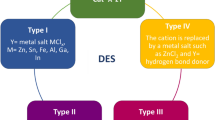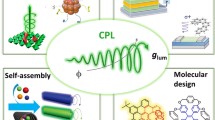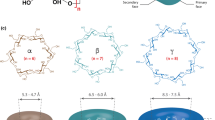Abstract
Efficient encapsulation of small molecules with supermolecules is one of significantly important subjects due to strong application potentials. This article presents the interaction between cryptophane-M and chloroform by fluorescence spectroscopy. The sonicated cryptophane-M solution exhibits light green color in chloroform, and the solid obtained from the evaporation of chloroform also has different color from that of cryptophane-M. In contrast, the sonicated cryptophane-M solutions in other solvents are colorless, and the solid obtained from the evaporation of these solvents has the same color as that of cryptophane-M. Furthermore, the freshly prepared cryptophane-M solution in different solvents is almost colorless, and the solid obtained from the evaporation of these solvents displays the same color as that of cryptophane-M. Although the sonicated cryptophane-M solutions in different solvents have very similar absorption spectra, they exhibit quite different emission spectra in chloroform. In contrast, the freshly-prepared cryptophane-M solutions show similar absorption and emission spectroscopy in various solvents. The variation of the fluorescence spectroscopy in binary solvents with the increasing chloroform ratio suggests that cryptophane-M and chloroform form a 1:1 exciplex, and the binding constant is estimated to be 292.95 M−1. Although all solvents are able to enter into the cavity of cryptophane-M, only chloroform can stay in the cavity of cryptophane-M for a while, which is mostly due to the strong intermolecular interaction between cryptophane-M and chloroform, and this results in the formation of the exciplex between them.










Similar content being viewed by others
References
Brotin T, Dutasta JP (2009) Cryptophanes and their complexes#present and future. Chem Rev 109(1):88–130
Chaffee KE, Fogarty HA, Brotin T, Goodson BM, Dutasta JP (2009) Encapsulation of small gas molecules by cryptophane-111 in organic solution. 1. Size- and shape-selective complexation of simple hydrocarbons. J Phys Chem A 113(49):13675–13684
Diez NM, de la Pena AM, Garcia MCM, Gil DB, Canada-Canada F (2007) Fluorimetric determination of sulphaguanidine and sulphamethoxazole by host-guest complexation in beta-cyclodextrin and partial least squares calibration. J Fluoresc 17(3):309–318
Enoch IVMV, Swaminathan M (2006) Fluorimetric study on molecular recognition of beta-cyclodextrin with 2-amino-9-fluorenone. J Fluoresc 16(4):501–510
Chen Y, Pang Y, Wu JL, Su Y, Liu JY, Wang RB, Zhu BS, Yao YF, Yan DY, Zhu XY, Chen Q (2010) Controlling the Particle Size of Interpolymer Complexes through Host-Guest Interaction for Drug Delivery. Langmuir 26(11):9011–9016
Benounis M, Jaffrezic-Renault N, Dutasta JP, Cherif K, Abdelghani A (2005) Study of a new evanescent wave optical fibre sensor for methane detection based on cryptophane molecules. Sens Actuators B 107(1):32–39
Kim BS, Ko YH, Kim Y, Lee HJ, Selvapalam N, Lee HC, Kim K (2008) Water soluble cucurbit[6]uril derivative as a potential Xe carrier for Xe-129 NMR-based biosensors. Chem Commun 24:2756–2758
Marjanska M, Goodson BM, Castiglione F, Pines A (2003) Inclusion complexes oriented in thermotropic liquid-crystalline solvents studied with carbon-13 NMR. J Phys Chem B 107(46):12558–12561
Chaffee KE, Marjanska M, Goodson BM (2006) NMR studies of chloroform@cryptophane-A and chloroform@bis-cryptophane inclusion complexes oriented in thermotropic liquid crystals. Solid State Nucl Mag 29(1–3):104–112
Bouchet A, Brotin T, Cavagnat D, Buffeteau T (2010) Induced chiroptical changes of a water-soluble cryptophane by encapsulation of guest molecules and counterion effects. Chem Eur J 16(15):4507–4518
Martinez A, Robert V, Gornitzka H, Dutasta JP (2010) Controlling helical chirality in atrane structures: solvent-dependent chirality sense in hemicryptophane-oxidovanadium(V) complexes. Chem Eur J 16(2):520–527
Tosner Z, Lang J, Sandstrom D, Petrov O, Kowalewski J (2002) Dynamics of an inclusion complex of dichloromethane and cryptophane-E. J Phys Chem A 106(38):8870–8875
Lang J, Dechter JJ, Effemey M, Kowalewski J (2001) Dynamics of an inclusion complex of chloroform and cryptophane-E: Evidence for a strongly anisotropic van der Waals bond. J Am Chem Soc 123(32):7852–7858
Roesky CEO, Weber E, Rambusch T, Stephan H, Gloe K, Czugler M (2003) A new cryptophane receptor featuring three endo-carboxylic acid groups: Synthesis, host behavior and structural study. Chem Eur J 9(5):1104–1112
Tosner Z, Petrov O, Dvinskikh SV, Kowalewski J, Sandstrom D (2004) A C-13 solid-state NMR study of cryptophane-E: chloromethane inclusion complexes. Chem Phys Lett 388(1–3):208–211
Garcia C, Humiliere D, Riva N, Collet A, Dutasta JP (2003) Kinetic and thermodynamic consequences of the substitution of SMe for OMe substituents of cryptophane hosts on the binding of neutral and cationic guests. Org Biomol Chem 1(12):2207–2216
Brotin T, Cavagnat D, Dutasta JP, Buffeteau T (2006) Vibrational circular dichroism study of optically pure cryptophane-A. J Am Chem Soc 128(16):5533–5540
Sun P, Jiang YD, Xie GZ, Du XS, Hu J (2009) A room temperature supramolecular-based quartz crystal microbalance (QCM) methane gas sensor. Sens Actuators B 141(1):104–108
Crassous J, Collet A (2000) The bromochlorofluoromethane saga. Enantiomer 5(5):429–438
Garel L, Lozach B, Dutasta JP, Collet A (1993) Remarkable effect of receptor size in the binding of acetylcholine and related ammonium-ions to water-soluble cryptophanes. J Am Chem Soc 115(24):11652–11653
Taratula O, Dmochowski IJ (2010) Functionalized 129Xe contrast agents for magnetic resonance imaging. Curr Opin Chem Biol 14(1):97–104
Brotin T, Darzac M, Forest D, Becchi M, Dutasta JP (2001) Formation of cryptophanes from their precursors as viewed by liquid secondary ion mass spectrometry. J Mass Spectrom 36(10):1092–1097
Huber G, Beguin L, Desvaux H, Brotin T, Fogarty HA, Dutasta JP, Berthault P (2008) Cryptophane-xenon complexes in organic solvents observed through NMR spectroscopy. J Phys Chem A 112(45):11363–11372
Petrov O, Tosner Z, Csoregh I, Kowalewski J, Sandstrom D (2005) Dynamics of chloromethanes in cryptophane-E inclusion complexes: A H-2 solid-state NMR and X-ray diffraction study. J Phys Chem A 109(20):4442–4451
Cavagnat D, Brotin T, Bruneel JL, Dutasta JP, Thozet A, Perrin M, Guillaume F (2004) Raman microspectrometry as a new approach to the investigation of molecular recognition in solids: Chloroform-cryptophane complexes. J Phys Chem B 108(18):5572–5581
Zhang CH, Shen WL, Wen GM, Chao JB, Qin LP, Shuang SM, Dong C, Choi MMF (2008) Spectral study on the interaction of cryptophane-A and neutral molecules CHnCl4-n (n=0, 1, 2). Talanta 76(2):235–240
Zhang CH, Shen WL, Fan RY, Zhang GM, Shuang SM, Dong C, Choi MMF (2010) Spectral study on the inclusion complex of cryptophane-E and CHCl3. Spectrochim, Acta Part A 75(1):157–161
Perrin DD, Armarego WLF, Perrin DR (1966) Purification of Laboratory Chemicals. Pergamon, New York
Canceill J, Collet A (1988) Two-step synthesis of D3 and C3h cryptophanes. JCS Chem Comm 9:582–584
Eaton DF (1988) Reference materials for fluorescence measurement. Pure & Appl Chem 60(7):1107–1114
Maus M, Retigg W, Bonafoux D, Lapouyade R (1999) Photoinduced intramolecular charge transfer in a series of differently twisted donor-acceptor biphenyls as revealed by fluorescence. J Phys Chem A 103(18):3388–3401
Lukeman M, Veal D, Wan P, Ranjit V, Munasinghe N, Corrie JET (2004) Photogeneration of 1, 5-naphthoquinone methides via excited-state (formal) intramolecular proton transfer (ESIPT) and photodehydration of 1-naphthol derivatives in aqueous solution. Can J Chem 82:240–253
The supporting data are available electronically on the supplementary material at http://www.springerlink.com/content/104905/
Kandagal PB, Ashoka S, Seetharamappa J, Shaikh SMT, Jadegoud Y, Ijare OB (2006) Study of the interaction of an anticancer drug with human and bovine serum albumin: spectroscopic approach. J Pharm Biomed Anal 41(2):393–399
Hyperchem 8.0 Package, Hyperchem Inc., Gainesville, FL
Acknowledgements
The work was supported by the National Natural Science Foundation of China (No.60871039), the Science and Technology Development Project of Chongqing (No.2009AC6157) and the Fundamental Research Funds for the Central Universities (No.CDJXS10122217).
Author information
Authors and Affiliations
Corresponding author
Electronic Supplementary Material
Below is the link to the electronic supplementary material.
ESM 1
(DOC 261 kb)
Rights and permissions
About this article
Cite this article
Shi, Y., Li, X., Yang, J. et al. Efficient Encapsulation of Chloroform with Cryptophane-M and the Formation of Exciplex Studied by Fluorescence Spectroscopy. J Fluoresc 21, 531–538 (2011). https://doi.org/10.1007/s10895-010-0739-5
Received:
Accepted:
Published:
Issue Date:
DOI: https://doi.org/10.1007/s10895-010-0739-5




